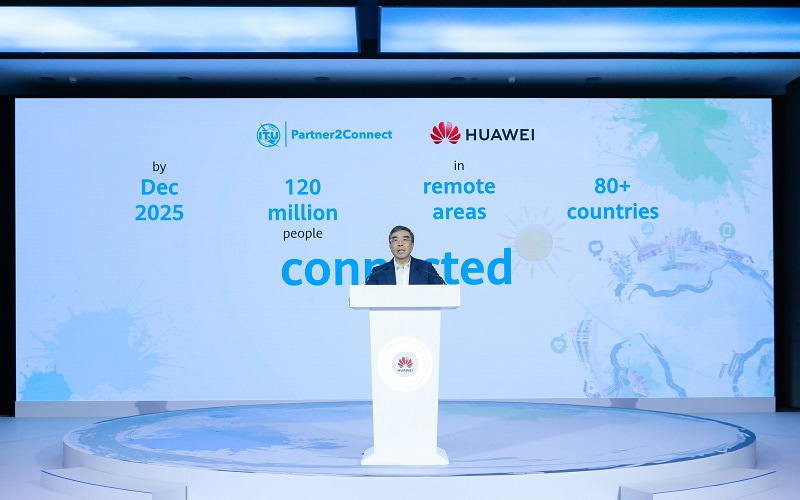[Shenzhen, China, November 23, 2022] Huawei has signed a global commitment to join the International Telecommunication Union’s Partner2Connect digital alliance, which will bring connectivity to about 120 million people in remote areas in more than 80 countries by 2025.
 Liang Hua, Chairman of Huawei announced the company had joined ITU P2C Digital Alliance
Liang Hua, Chairman of Huawei announced the company had joined ITU P2C Digital Alliance
Liang Hua, Chairman of Huawei, announced the decision at the company’s 2022 Sustainability Forum, Connectivity+: Innovate for Impact. The forum explored how ICT innovation could unleash the business and social value of connectivity and drive sustainability in the digital economy era.
Speakers at the event included senior leaders from the ITU and United Nations, telecom ministers and regulators in Cambodia, Nigeria, Bangladesh, and Pakistan, and business leaders, partners, experts, and customers from China, South Africa, Belgium, and Germany.
“It is clear connectivity alone is not enough. It must be affordable, the content must be relevant and in the local language, and users must have the skills to make best use of it,” said ITU Deputy Secretary-General Malcolm Johnson. “Thank you to Huawei for their support of the Partner2Connect (P2C) Digital Coalition, and for their announced P2C pledges in the key areas of rural connectivity and digital skills.”
Siddharth Chatterjee, United Nations Resident Coordinator in China, called for “multi-stakeholder partnerships” of policymakers, the private sector, academia, and civil society to close “the sobering reality” of a digital divide which excluded a third of the global population.
“Our dynamic world urgently needs improved digital cooperation to capitalize on the transformational potential of technology to create new jobs, boost financial inclusion, close the gender gap, spur a green recovery and redesign our world to be more prosperous and inclusive,” he said. “Now is the time to act”.
In his keynote address, Dr Liang stressed that access to a stable network was a basic requirement and right in the digital age. For many who remain unconnected, access to reliable connectivity would mark the first step towards transforming their lives.
“Connectivity will be more than just a tool for convenient communications,” he said. “Together with digital technologies like cloud and AI, connectivity will help bring everyone into the digital world, and provide them with access to more information and skills, better services, and wider business opportunities. This will, in turn, drive further social and economic development.”
Cao Ming, President of Huawei Wireless Solution, said: “As an enterprise with the most complete ICT capabilities, Huawei integrates the full-technology innovation potential of equipment, sites, energy, transmission, and antennas to address the difficulties faced by traditional site deployment, such as high costs, restricted transportation, lack of power, and maintenance challenges. We have continuously upgraded the RuralStar and RuralLink solutions to extend quality coverage to remote areas, enabling more people, community hospitals, schools, local governments, and small- and medium-sized enterprises to enjoy the same high-speed broadband connectivity experiences as those in cities”.
The RuralStar series solutions have provided connections for more than 60 million people in remote areas in more than 70 countries.
The construction of optical broadband networks offers another important route to realizing a universal service. Huawei has proposed an innovative AirPON solution for areas with low population density, including remote areas. This solution continuously reduces the footprint of equipment rooms, optical fiber installation costs, and network power consumption, while ensuring the rapid deployment of local communication networks.
In Africa alone, Huawei has laid more than 250,000 kilometers of optical fibers, enabling 30 million households to access high-speed broadband. User experience has seen constant improvement. The average speed of home broadband already exceeds 30 Mbit/s, bringing smarter, faster, and smoother home network experience.
As ICT infrastructure continues to evolve, innovative technologies like cloud and AI are allowing those in rural and remote areas to enjoy the convenience of a digital world. Huawei Cloud has proposed the Everything as a Service strategy and made Huawei’s more than 30 years of technical expertise and digital transformation experience available through cloud services. This means that access to Huawei’s digital infrastructure capabilities on the cloud is now just as easy, affordable, and sustainable as water and electricity.
Digital transformation, digital talent, and new business models are all essential for balanced development in remote regions. Huawei previously announced that by 2025, with the improved ICT infrastructure, the company will work with partners to enable 500 million people to enjoy digital financial services and 500,000 people to enjoy inclusive education.
In Cambodia, the ITU’s first P2C partner country, Huawei will work with government departments through the Ministry of Posts and Telecommunications and universities to provide 10,000 training opportunities for ICT professionals in the next five years.
Huawei is committed to inclusive development. Through its ongoing technological innovation, Huawei is contributing to a higher level of digitalization in remote regions, enabling everyone to enjoy the convenience of a digital life, and promoting the balanced development of the global digital economy.
PR Archives: Latest, By Company, By Date